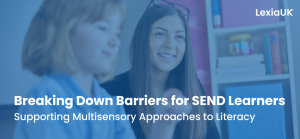Introduction
For many pupils with special educational needs and disability (SEND), learning to read and write can be a significant challenge. Difficulties with phonics, comprehension, and spelling often lead to frustration, disengagement, and low confidence. Traditional, one-size-fits-all approaches may not provide the flexibility or reinforcement these learners need.
This is where multisensory learning can play a transformative role. By engaging multiple senses—sight, sound, movement, and touch—multisensory strategies help embed literacy skills in a way that feels natural and meaningful to pupils with SEND. In this article, we’ll explore how multisensory learning works, practical strategies that can be used in the classroom, and how technology can enhance these approaches to break down barriers for learners with SEND.

What is Multisensory Learning and Why Does It Work?
Multisensory learning involves using visual, auditory, and kinaesthetic-tactile pathways simultaneously to support literacy development. This approach is particularly beneficial for pupils with SEND, such as those with dyslexia, dyspraxia, ADHD, or speech and language difficulties, as it reinforces learning through different modalities making it more likely to stick.
Why is it effective?
- Supports memory retention – Engaging multiple senses strengthens neural connections, helping learners retain and recall information.
- Reduces cognitive overload – Breaking down complex literacy tasks into sensory-based activities makes them more manageable.
- Encourages engagement – Pupils are more likely to stay focused when lessons include movement, hands-on activities, and interactive elements.
- Caters to diverse learning styles – Some pupils learn best by hearing information, others by seeing it, and others by doing. A multisensory approach meets all these needs.
Multisensory instruction is not just a theory—it is backed by research and widely used in evidence-based literacy programmes to support struggling learners.
Practical Multisensory Strategies for Literacy
Visual Strategies
Engaging the visual sense can help learners understand and remember literacy concepts more effectively. Some simple techniques include:
- Colour coding – Assign different colours to sounds, word patterns, or parts of speech to help pupils distinguish between them.
- Graphic organisers – Use story maps, sequencing charts, and mind maps to support comprehension.
- Word walls and picture clues – Reinforce vocabulary with images alongside words to aid recall.
Auditory Strategies
Many learners benefit from hearing information repeated and reinforced through sound-based activities, such as:
- Phonemic awareness games – Clapping syllables, rhyming activities, or blending sounds aloud.
- Verbal repetition and echo reading – Reading aloud together or repeating words to build fluency.
- Text-to-speech tools – Using assistive technology to support independent reading.
Kinaesthetic and Tactile Strategies
For many pupils, movement and touch-based activities can make literacy learning more engaging and memorable:
- Air writing and tracing – Encouraging pupils to trace letters in the air or on textured surfaces (e.g. sand trays).
- Movement-based learning – Hopping on letters, jumping to syllables, or moving counters when segmenting words.
- Hands-on letter building – Using magnetic letters, Play-Doh, or foam letters to physically construct words.
Combining Modalities for Maximum Impact
The most effective multisensory strategies often combine two or more senses at once. For example:
- Say it, See it, Do it – When learning new words, pupils say the word (auditory), see it on a flashcard (visual) and write it in the air (kinaesthetic).
- Tactile phonics – Pupils use their fingers to trace over textured letters while simultaneously saying the sound aloud.
By incorporating multisensory techniques, teachers can create an inclusive classroom environment where all pupils have the opportunity to thrive in literacy learning.
How Technology Can Enhance Multisensory Learning
While hands-on activities are highly effective, digital tools can also provide valuable multisensory learning experiences.
Technology can:
- Adapt to individual learning needs, offering personalised pathways for pupils.
- Provide interactive, gamified experiences that engage learners through sound, movement, and visual elements.
- Deliver embedded scaffolded support, offering real-time corrective feedback with visual and auditory instruction, and guided practice to reinforce learning.
Breaking Barriers with Lexia Core5 Reading
At LexiaUK, we understand the importance of adaptive, multisensory learning in literacy development. Lexia Core5 Reading is designed with evidence-based multisensory techniques, supporting pupils through a structured, personalised programme that integrates visual, auditory, and kinaesthetic-tactile elements. Schools using Lexia have reported increased engagement, improved reading confidence, and measurable progress among their SEND learners.
Would you like to see how an adaptive, personalised and multisensory approach can support your pupils?
Are you ready to accelerate literacy with our ground-breaking reading software for primary schools?
Spare 30 seconds to complete our contact form and one of our team will get in touch to discuss your requirements. Alternatively, call on 0191 482 1939.
